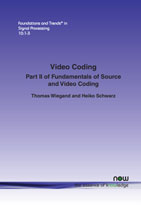Video Coding: Part II of Fundamentals of Source and Video Coding
By Thomas Wiegand, Berlin Institute of Technology and Fraunhofer Institute for Telecommunications - Heinrich Hertz Institute, Germany, thomas.wiegand@tu-berlin.de | Heiko Schwarz, Fraunhofer Institute for Telecommunications — Heinrich Hertz Institute, Germany, heiko.schwarz@hhi.fraunhofer.de
Abstract
Digital video coding technologies have become an integral part of the way we create, communicate, and consume visual information. In the first part of this two-part text, we introduced the fundamental source coding techniques entropy coding, quantization, prediction, and transform coding. The present second part describes the application of these techniques to video coding. We introduce the basic design of hybrid video encoders and decoders, explain the basic concepts of intra-picture coding, motion-compensated prediction, and prediction error coding, and discuss encoder optimization techniques. Special emphasis is put on a fair analysis of various design aspects and coding tools in terms of coding efficiency. We highlight the application of the discussed concepts in modern video coding standards and compare important standards with respect to the achievable coding efficiency.
Video Coding: Part II of Fundamentals of Source and Video Coding
Video Coding is the second part of the two-part monograph Fundamentals of Source and Video Coding by Wiegand and Schwarz. This part describes the application of the techniques described in the first part to video coding. In doing so it provides a description of the fundamentals concepts of video coding and, in particular, the signal processing in video encoders and decoders.
The monograph describes the basic structure of video codecs, discusses the fundamental concepts of video coding, and highlights their application in modern video coding standards. The effectiveness of various coding tools is demonstrated based on experimental results.
The text is aimed at students and engineers who wish to explore the subject. It provides an in-depth treatment of the basic principles and coding tools found in modern video codecs. Real world examples and analysis of certain coding tools are given by referring to video coding standards. These standards do not only represent the dominant technology for real-world applications, but also reflect the state-of-the-art in the field of video coding.
Video Coding is suitable as a primary text for courses on this subject. It can also be used as a resource for teaching and as a comprehensive reference for professional engineers and academic researchers.

Companion
Source Coding: Part I of Fundamentals of Source and Video Coding , Foundations and Trends® in Signal Processing, Volume 4, Issue 1–2 10.1561/2000000010